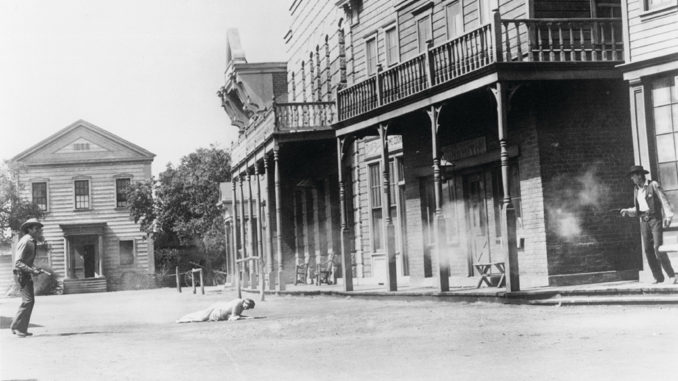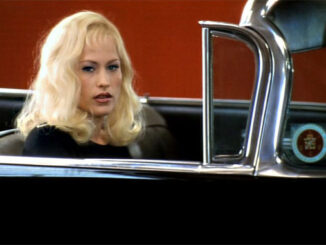
by Kevin Lewis
I decided to treat the film as if it was a story a grandfather might tell his grandson,” recalled Elmo Williams, ACE, on his 94th birthday earlier this year. He was talking about High Noon (1952), the film for which he won the Oscar for editing (shared with Harry Gerstad). Though countless articles have been written about this Western allegory––including conflicting accounts by its producer Stanley Kramer, screenwriter Carl Foreman and director Fred Zinnemann–– perhaps Williams’ simple rationale that the film is akin to folklore is the reason for its adoption by succeeding generations of fans.
Williams, who was born in Oklahoma and grew up in New Mexico when it was still the Old West, recalls similar shoot-out stories related to him by his father and grandfather––who was a boy himself during the time this late 19th century Western saga was set. In his recently published autobiography, Elmo Williams: A Hollywood Memoir (McFarland, 2006), he tells his side of the making of this heralded film––along with other stories from his long career.
Because Foreman was blacklisted during the House Un-American Activities Committee (HUAC) era, High Noon has often been interpreted as an anti-McCarthy era story of mass cowardice when confronted by evil. John Wayne publicized this aspect and made Rio Bravo (1959) as a rebuttal. But Gary Cooper, who won his second Oscar as Sheriff Will Kane, the man who must face down four killers alone at high noon without the support of the town’s hiding citizens, didn’t accept this explanation. And Cooper was a friendly witness at the HUAC hearings, but did not name names.
It is a moot point now because the story has multiple meanings as a personal epiphany. Former President Bill Clinton reportedly saw it 17 times, and it is said to be a favorite of other US presidents. High Noon was a classic the day it was released in July 1952, and was admitted to the National Film Registry of the National Film Preservation Board in the first eligible year, 1989.
High Noon has always been regarded as an editor’s film because it is so different from conventional Hollywood’s “A” productions of the time, which were dialogue-, actor- and director-driven.
While Zinnemann rejected blanket statements that the editing and then re-editing by Williams saved the film after its lukewarm premiere showings, he did acknowledge that he, Foreman, composer Dimitri Tiomkin and Williams were the collaborators that made the film a classic. Zinnemann and Williams had a good relationship. Kramer was dissatisfied, however, with the original cut approved by Zinnemann, and Foreman––who was a co-producer with Kramer–– had already fled to England ahead of the HUAC. Williams offered to re-edit the film over a weekend, but Kramer was skeptical. “What can you do over a weekend?” he asked. Williams said it was worth a try.
It was easier said than done. Foreman had written the script, which was an adaptation of the 1947 short story The Tin Star by John Cunningham, as a real-time film, set between 10:35 a.m. and 12:15 p.m. “Since the story of High Noon was to play out in the same time as the screening time of the film when it was released, Fred made a point of keeping a clock in the background of every shot,” writes Williams in his autobiography. “The admirable concept was eventually to prove a difficult one when I started rearranging continuity.”
The clocks in the background was a big problem, according to Williams, because the time was seldom correct for a real-time film. “When you’re an editor, quite often you are faced with a situation where you want to lead the audience’s eye someplace, so they’re not going to pick up mistakes,” he explains. “That’s what I used whenever I was forced to put in a clock with the wrong time; I had an action motion that would take your eye away from the clock.” Williams also claims he shot a number of close-ups of clocks and used them throughout the film to show the passage of time and to build tension. He also added shots of the railroad tracks, cut out some side stories and trimmed the part of the Quaker bride of Kane, played by Grace Kelly.
High Noon has often been interpreted as an anti-McCarthy era story of mass cowardice when confronted by evil. John Wayne publicized this aspect and made Rio Bravo [1959] as a rebuttal.
“[Kelly] was a force in the film, but her scenes didn’t help the progression at all, so I cut a lot of the scenes that Zinnemann had put in of her,” Williams continues. “But I knew it was important to keep her alive, because she was the moral force behind the whole thing. That’s why whenever Cooper walked down the street, I would put in a strain of ‘Do Not Forsake Me, O My Darlin’.’ The viewer would think that Cooper was thinking only of his woman and her moral fiber. By adding little phrases [from the song], I would keep Grace very much alive, though she was not in the film that much.”
Those cuts brought the film down to 70 minutes, below the real time of the story, so Kramer ordered at least 20 minutes restored to it for a feature length. The side stories could not be replaced because they slowed down the pace of the story, according to Williams, who said he added back in scenes involving Katy Jurado, whose character of the Mexican mistress represents “the cynical moral center” of the town as well as the sheriff’s former life. The 85-minute film never quite made the 100 minutes of real time, but few noticed because the tension was so great.
High Noon has always been regarded as an editor’s film because it is so different from conventional Hollywood’s “A” productions of the time, which were dialogue-, actor- and director-driven. Cinematographer Floyd Crosby created the artistic look of 19th century Old West photographs by shooting high-contrast black-and-white film stock without filters and pushing the film a few stops lighter than normal. The close-ups of the weather-beaten face of Cooper in this process emphasized the similar historic stature of the veteran Western movie star and the Old West’s actual characters.
Foreman claimed that Kramer bought The Tin Star to avoid a copyright infringement suit over the film and there remain many similarities between the story’s arthritic Sheriff Will Doane and the weary, old-before-his-years Sheriff Will Kane. The similarities were heightened by those close-ups, which revealed real torment and fear in Cooper’s eyes and muscles because he was suffering from a bleeding ulcer and back pain. Doane was killed in the story, but who would pay to see Cooper die? Hollywood wept real tears when he did pass away just a few years later.
While you are watching the film today, either on the big screen or on your home entertainment system, someone somewhere is struggling through his or her own personal “High Noon.” The film is simply that iconic.





